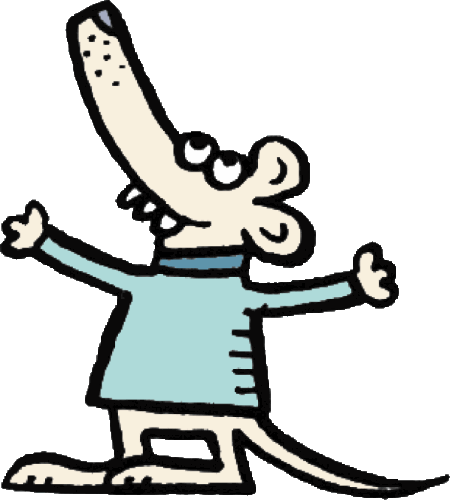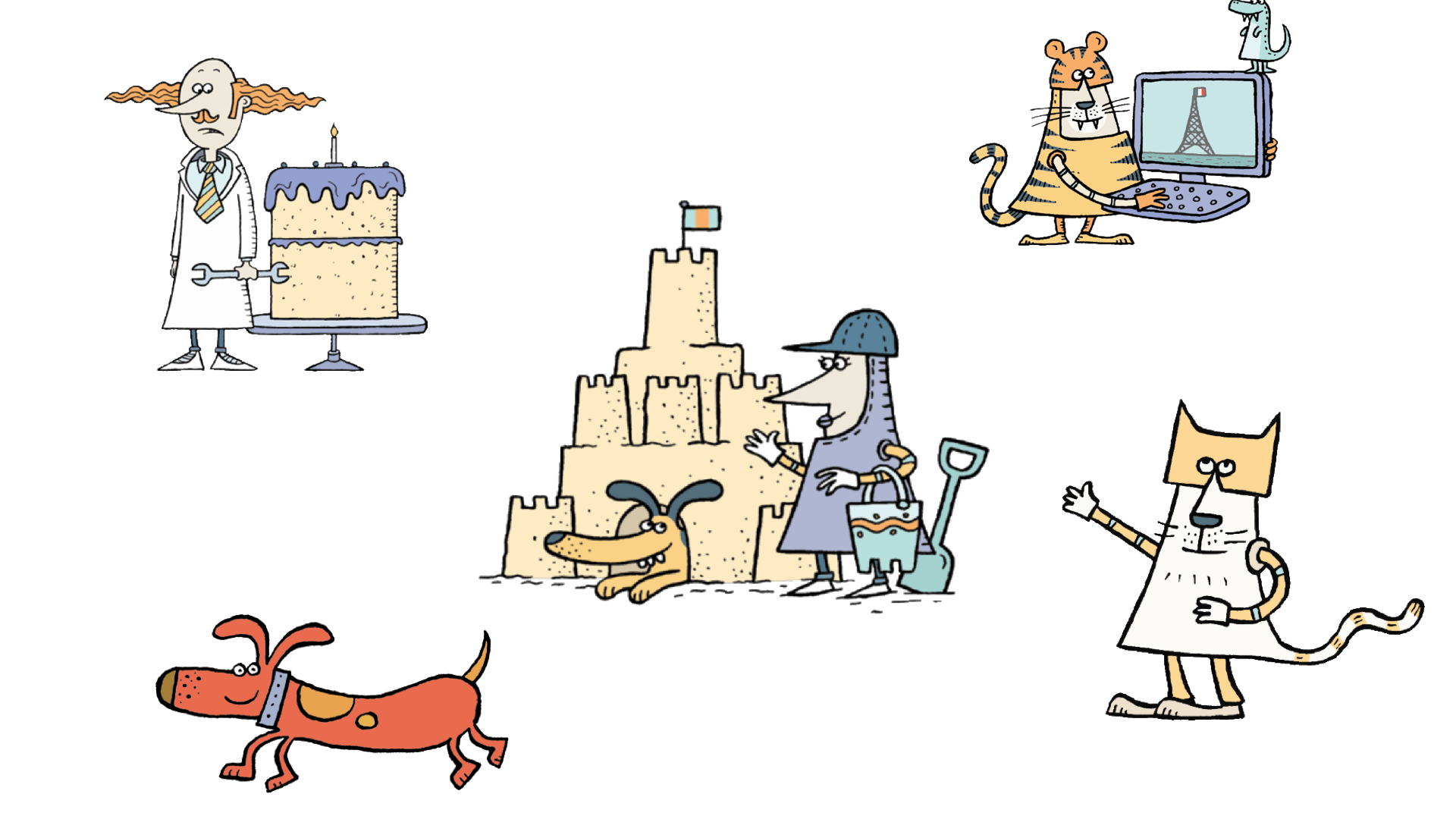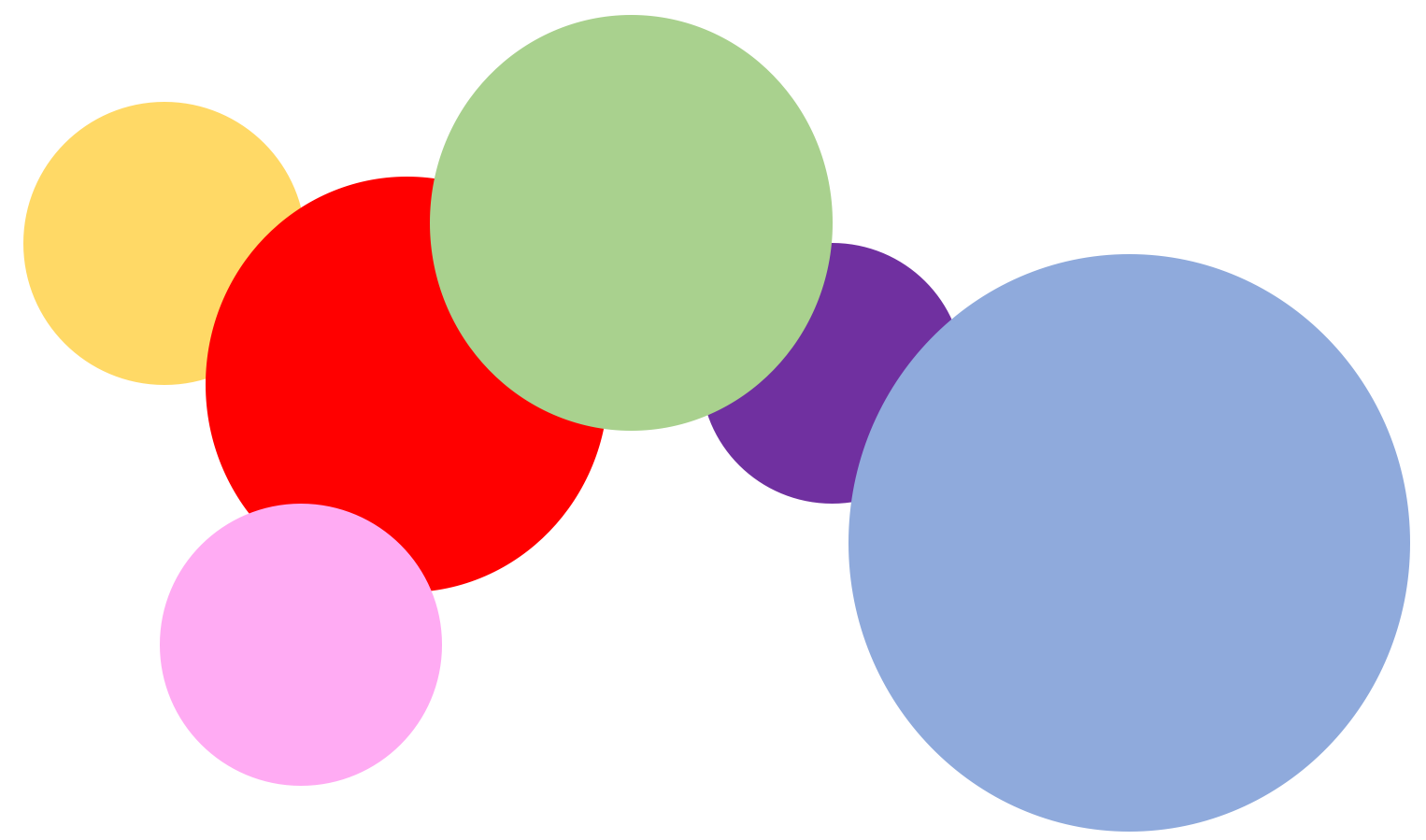Words
Activity 1
Show learners the image in the first slide. Ask them to work with a partner and write down as many words as they can see. Share back with the whole class and accept any valid answers.
Activity 2
Show learners the list of actions. Ask them to put the letters a-f in the appropriate order. Circulate and accept any reasonable answers. On the next slide, disucss possible solutions as a whole class.
Activity 3
Show learners the multi-coloured circles. Ask them to identify and write down all the colours they can see.
Activity 4
Ask leaners to look back on the three activities. Explain that they have been working with three special types of words that do different jobs.
Check their understanding by completing the next task. Learners identify which of the words are nouns, verbs and adjectives.
Nouns: dog, cake, computer
Verbs: have (breakfast), clean (my teeth), get up
Adjectives: yellow, red, blue
Finally, ask learners to write a paragraph about getting ready in the morning. You may like to start by modelling an example paragraph as a whole class. Ask learners to include nouns, verbs and adjectives they have seen in the day's lesson, and to write at least six sentences. As an extension, learners can include extra nouns, verbs and adjectives and swap with a partner to identify them.
This lesson is adapted (with permission) from Words and Meanings: A Systematic Guide for the Teaching of English Vocabulary, by Gabriele Stein.
Welcome!

Englicious is totally free for everyone to use!
But in exchange, we ask that you register for an account on our site.
If you’ve already registered, you can log in straight away.
Since this is your first visit today, you can see this page by clicking the button below.
Words
Objective
To explore the meaning of simple, everyday words and how they relate to your experience of the world.
Activity 1
There are many kinds of words.
Do you know the words for what you see in the picture? Talk to a partner and write down as many words as you can.

Activity 2
Can you describe what you do in the morning before you go to school? Here is a list of what you might do, but the order in which you do things has been mixed up:
a) have breakfast.
b) get dressed.
c) put on my shoes.
d) get up.
e) clean my teeth.
f) have a shower
In the next activity, try agreeing on the order with the whole class.
Activity 3
Here are pictures of some colours which things can have:

Write the name of all the colours you can see.
Activity 4
You have now used words to describe what things look like, to tell us what you do in the morning and to give a name to some objects. We have special names for different types of words:
- Words which tell us what something looks like, how it is, are called adjectives.
- Words which refer to actions, to what is being done are called verbs
- Words which provide a name for a thing or object, for a person or an animal are called nouns.
Match each of the words from the previous activity to the other word class it belongs to.
Add three extra examples to each category.
Write a paragraph about getting ready for school in the morning.
- Use nouns, adjectives and verbs from the previous activities.
- Write at least six sentences.
This lesson is adapted (with permission) from Words and Meanings: A Systematic Guide for the Teaching of English Vocabulary, by Gabriele Stein.
Nouns and Vocabulary
Activity 1
Show the leaners the the list of nouns. After hearing their ideas, explain what concrete nouns are, and ask leaners if they can see or find any other examples in the classroom. Explain what abstract nouns are and ask for any other examples.
Next, ask the learners to work in pairs and small groups. Copy down the table and decide which nouns are concrete or abstract. Check the answers as a whole class.
Concrete: spoon, bed, grass, snow, clock, panda, pillar
Abstract: idea, joy, happiness, truth, difficulty
Activity 2
Next learners will focus on nouns to do with places. Ask learners how many places they can think of in one minute. Ask them to share and compare with a partner.
Move to the next slide. Show the quiz questions and ask learners to identify the correct place noun. Check answers as a whole class.
Activity 3
Finally, ask learners to list as many concrete and abstract nouns that they can spot in the classroom.
This lesson is adapted (with permission) from Words and Meanings: A Systematic Guide for the Teaching of English Vocabulary, by Gabriele Stein.
Welcome!

Englicious is totally free for everyone to use!
But in exchange, we ask that you register for an account on our site.
If you’ve already registered, you can log in straight away.
Since this is your first visit today, you can see this page by clicking the button below.
Nouns and vocabulary
Objective
To explore the meaning of simple, everyday nouns, and how they relate to your experience of the world.
Activity 1
Look at this list of nouns: chair, fork, dog, house, person, football player
What do they all have in common?
Nouns like chair, fork, dog, house, person, football player are all things that we can see and touch.
They exist in reality and are observable. They are all examples of concrete nouns.
Can you think of another type of nouns that are not concrete?
This other type of nouns refers to ideas or feelings which we cannot see or touch.
Nouns like happiness, time or fear
Such nouns are called abstract nouns.
The box below contains concrete nouns and abstract nouns. Can you sort them into the correct group?
Activity 2
Another type of concrete noun are those naming places.
How many different words for places can you think of in a minute?
Here are some familiar names denoting places. Can you match them with their descriptions?
Answers
Activity 3
Look around the classroom and talk to your partner.
- How many concrete objects can you see that you can name using a noun?
- How many abstract nouns can you think of?
This lesson is adapted (with permission) from Words and Meanings: A Systematic Guide for the Teaching of English Vocabulary, by Gabriele Stein.
Welcome!

Englicious is totally free for everyone to use!
But in exchange, we ask that you register for an account on our site.
If you’ve already registered, you can log in straight away.
Since this is your first visit today, you can see this page by clicking the button below.
Gender in Nouns
Activity 1
Explain to the learners that nouns can refer to male or female people. In language, this difference is called gender.
Ask learners to copy down the list and add the nouns of the oppsite gender. Show them the solutions and ask them what patterns they notice. Answer: some are completely different words while others use a suffix to change the meaning.
Activity 2
Explain to the learners the suffix -ess can be used to turn nouns referring to males into nouns referring to females. Ask them to copy and convert the list of nouns, and to check whether they need any further spelling changes e.g. god/goddess.
Activity 3
Explain to learners how nouns can refer to either male or female individuals. Common gender nouns can refer to individuals of either gender. Neuter gender nouns refer to entities with no gender. Ask them to copy the list of words and then to categorise them accordingly. Check the answers as a whole class.
Male: monk, boy, son, brother, uncle, king
Female: nun, girl, daughter, sister, aunt
Common: doctor, guest, student, friend, servant, enemy, child, cook
Neuter: milk, bridge, jacket, road, cup, finger
Activity 4
Ask the learners read the ten sentences in pairs or small groups and discuss the questions.
The learners can tell the gender by using pronouns (she), honorifics (Mr.) or pronouns (hers).
In sentence 3, the gender of the 'guest' is not apparent.
This lesson is adapted (with permission) from Words and Meanings: A Systematic Guide for the Teaching of English Vocabulary, by Gabriele Stein.
Welcome!

Englicious is totally free for everyone to use!
But in exchange, we ask that you register for an account on our site.
If you’ve already registered, you can log in straight away.
Since this is your first visit today, you can see this page by clicking the button below.
Gender in Nouns
Objective
To explore the meaning of gender in nouns.
Activity 1
What's the difference between the words mother and father?
Nouns for people can refer to a man or a male such as father or to a woman or female such as mother .
In language, we call this difference gender.
For each noun, write the word that expresses the opposite gender:
- boy
- grandad
- waiter
- king
- son
- nephew
- uncle
- empress
- bride
- heroine
- actress
- princess
Here are the solutions.
What do you notice about how the opposites are formed? Do they all follow the same pattern?
- boy - girl
- grandad - grandma
- waiter - waitress
- king - queen
- son - daughter
- nephew - niece
- uncle - aunty
- empress - emperor
- bride - groom
- heroine - hero
- actress - actor (though increasingly actor is now used for both genders)
- princess - prince
Activity 2
What do these examples have in common?
prince - princess
actor - actress
The examples prince - princess and actor - actress show that the form for the female person can be made by adding the suffix -ess to the word for the male person.
There may be changes to the spelling as in actor - actress.
Here are a number of nouns denoting a male person. Form the name for the female person by adding the suffix -ess:
- baron
- giant
- god
- heir
- host
- mayor
- peer
Here are the solutions. How many of them required a spelling change?
- baron - baroness
- giant - giantess
- god - goddess
- heir - heiress
- host - hostess
- mayor - mayoress
- peer - peeress
Activity 3
Most nouns do not have male or female gender.
Some nouns like parent can refer to either gender i.e. to a male or female person. These words are called common gender nouns.
Nouns like door or window have no gender and are known as neuter.
Check the following nouns very carefully and then sort them into the appropriate group:
The sentences below include a common gender noun. Can you use any clues to work out the gender of the person referred to in blue? Make sure to look at all the words in the sentence to find the clues.
- Mrs Brown is a teacher.
- Bill's uncle became a successful photographer.
- She brought a guest to the party
- His little brother had always wanted to be a writer.
- The artist had her first exhibition last year.
- The teacher was welcomed by her student.
- He is an assistant in a big shop.
- Their daughter was a doctor in South Africa.
- Heather has been their cook for eight years now.
- Mr Roberts has now become Mary's enemy number 1.
This lesson is adapted (with permission) from Words and Meanings: A Systematic Guide for the Teaching of English Vocabulary, by Gabriele Stein.